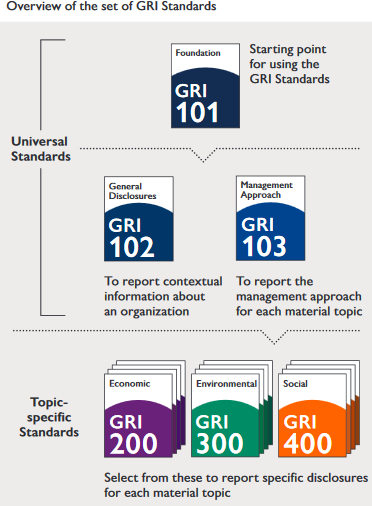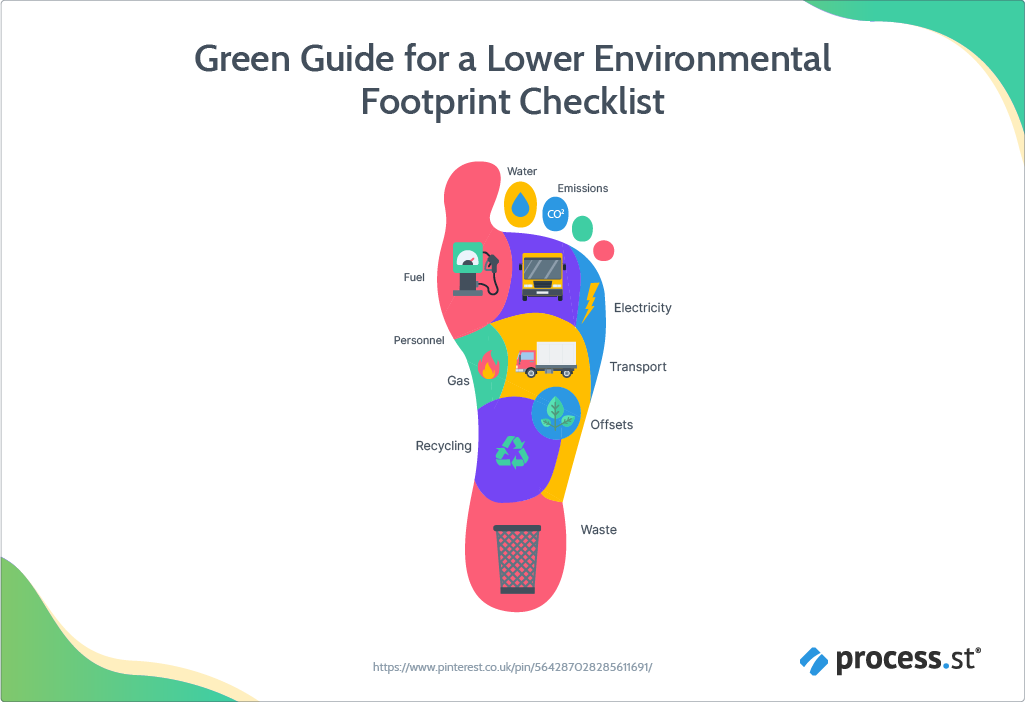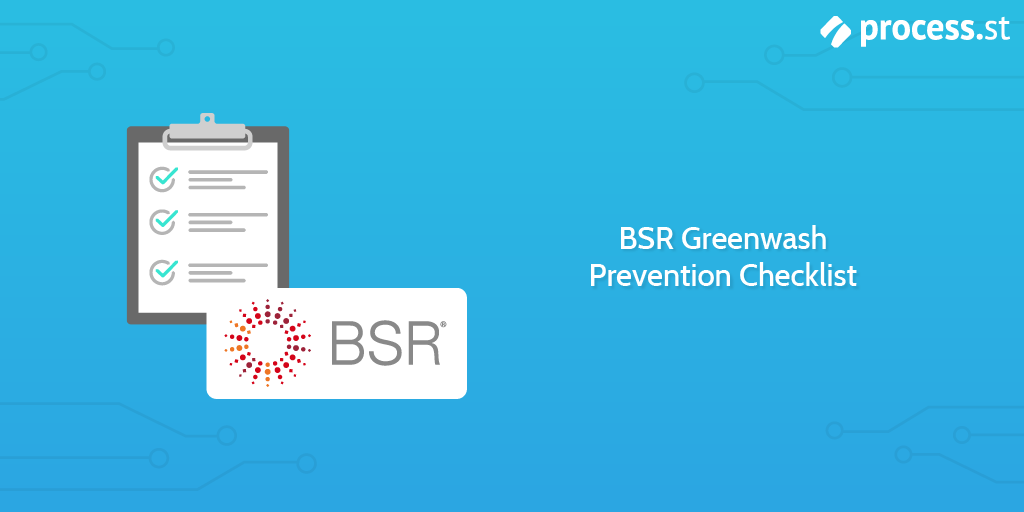Report content requirements
Organizational Profile
102.1 The reporting organization shall report the following information:
a. Name of the organization.
{{form.Notes_on_disclosure_102-1}}
102-2 The reporting organization shall report the following information:
a. A description of the organization's activities;
b. Primary brands, products, and services, including an explanation of any products or services that are banned in certain markets.
{{form.Notes_on_disclosure_102-2}}
102-3 The reporting organization shall report the following information:
a. Location of the organization's headquarters.
{{form.Notes_on_disclosure_102-3}}
102-4 The reporting organization shall report the following information:
a. The number of countries where the organization operates, and the names of the countries where it has significant operations and/or that are relevant to the topics covered in the report.
{{form.Notes_on_disclosure_102-4}}
102-5 The reporting organization shall report the following information:
a. Nature of ownership and legal form.
{{form.Notes_on_disclosure_102-5}}
102-6 The reporting organization shall report the following information:
a. Markets served, including:
i. geographic locations where products and services are offered;
ii. sectors served;
iii. types of customers and beneficiaries.
{{form.Notes_on_disclosure_102-7}}
102-7 The reporting organization shall report the following information:
a. The scale of the organization, including:
i. total number of employees;
ii. total number of operations;
iii. net sales (for private sector organizations) or net revenues (for public sector organizations);
iv. total capitalization (for private sector organizations) broken down in terms of debt and equity;
v. quantity of products or services provided
{{form.Notes_on_disclosure_102-7}}
102-8 The reporting organization shall report the following information:
a. Total number of employees by employment contract (permanent and temporary), by gender;
b. Total number of employees by employment contract (permanent and temporary), by region;
c. Total number of employees by employment types (full-time and part-time), by gender;
d. Whether a significant portion of the organization's activities is performed by workers who are not employees. If applicable, a description of the nature and scale of work performed by workers who are not employees;
e. Any significant variations in the numbers reported in Disclosures 102-8-a, 102-8-b, and 102-8-c (such as seasonal variations in the tourism or agricultural industries);
f. An explanation of how the data has been compiled, including any assumptions made.
{{form.Notes_on_disclosure_102-8}}
102-9 The reporting organization shall report the following information:
a. A description of the organization's supply chain, including its main elements as they relate to the organization's activities, primary brands, products, and services.
{{form.Notes_on_disclosure_102-9}}
102-10 The reporting organization shall report the following information:
a. Significant changes to the organization's size, structure, ownership, or supply chain, including:
i. Changes in the location of, or changes in operations, including facility openings, closings, and expansions;
ii. Changes in the share capital structure and other capital formation, maintenance, and alteration operations (for private sector organizations);
iii. Changes in the location of suppliers, the structure of the supply chain, or relationships with suppliers, including selection and termination.
{{form.Notes_on_disclosure_102-10}}
102-11 The reporting organization shall report the following information:
a. Whether and how the organization applied the Precautionary Principle or approach.
{{form.Notes_on_disclosure_102-11}}
102-12 The reporting organization shall report the following information:
a. A list of externally-developed economic, environmental and social charters, principles, or other initiatives to which the organization subscribes, or which it endorses.
{{form.Notes_on_disclosure_102-12}}
102-13 The reporting organization shall report the following information:
a. A list of the main membership of industry or other associations, and national or international advocacy organizations.
{{form.Notes_on_disclosure_102-13}}
Strategy
102-14 The reporting organization shall report the following information:
a. A statement from the most senior decision-maker of the organization (such as CEO, chair, or equivalent senior position) about the relevance of sustainability to the organization and its strategy for addressing sustainability.
{{form.Notes_on_disclosure_102-14}}
102-15 The reporting organization shall report the following information:
a. A description of key impacts, risks, and opportunities.
{{form.Notes_of_disclosure_102-16}}
Ethics and Integrity
102-16 The reporting organization shall report the following information:
a. A description of the organization's values, principles, standards, and norms of behavior.
{{form.Notes_of_disclosure_102-16}}
102-17 The reporting organization shall report the following information:
a. A description of internal and external mechanisms for:
i. seeking advice about ethical and lawful behavior, and organizational integrity;
ii. reporting concerns about unethical or unlawful behavior, and organizational integrity.
{{form.Notes_on_disclosure_102-17}}
Governance
102-18 The reporting organization shall report the following information:
a. The governance structure of the organization, including committees of the highest governance body;
b. Committee's responsible for decision-making on economic, environmental, and social topics.
{{form.Notes_on_disclosure_102-18}}
102-19 The reporting organization shall report the following information:
a. Process for delegating authority for economic, environmental, and social topics from the highest governance body to senior executives and other employees.
{{form.Notes_on_disclosure_102-19}}
102-20 The reporting organization shall report the following information:
a. Whether the organization has appointed an executive-level position or positions with responsibility for economic, environmental, and social topics;
b. Whether post holders report directly to the highest governance body.
{{form.Notes_on_disclosure_102-20}}
102-21 The reporting organization shall report the following information:
a. Processes for consultation between stakeholders and the highest governance body on economic, environmental, and social topics.
b. If consultation is delegated, describe to whom it is delegated to and how the resulting feedback is provided to the highest governance body.
{{form.Notes_on_disclosure_102-21}}
102-22 The reporting organization shall report the following information:
a. Composition of the highest governance body and its committees by:
i. executive or non-executive;
ii. independence;
iii. tenure on the governance body;
iv. number of each individual's other significant positions and commitments, and the nature of the commitments;
v. gender;
vi. membership of under-represented social groups;
vii. competencies relating to economic, environmental, and social topics;
viii. stakeholder representation.
{{form.Notes_on_disclosure_102-22}}
102-23 The reporting organization shall report the following information:
a. Whether the chair of the highest governance body is also an executive officer in the organization;
b. If the chair is also an executive officer, describe his or her function within the organization's management and the reasons for this arrangement.
{{form.Notes_on_disclosure_102-23}}
102-24 The reporting organization shall report the following information:
a. Nomination and selection processes for the highest governance body members, including whether and how:
i. stakeholders (including shareholders) are involved;
ii. diversity is considered;
iii. independence is considered;
iv. expertise and experience relating to economic, environmental, and social topics are considered.
{{form.Notes_on_disclosure_102-24}}
102-25 The reporting organization shall report the following information:
a. Processes for the highest governance body to ensure conflicts of interest are avoided and managed.
b. Whether conflicts of interest are disclosed to stakeholders, including, at a minimum:
i. Cross-board membership;
ii. Cross-shareholding with suppliers and other stakeholders;
iii. Existences of controlling shareholder;
iv. related party disclosures.
{{form.Notes_on_disclosure_102-25}}
102-26 The reporting organization shall report the following information:
a. Highest governance body's and senior executives' role in the development, approval, and updating of the organization's purpose, value or mission statements, strategies, policies, and goals related to economic, environmental, and social topics.
{{form.Notes_on_disclosure_102-26}}
102-27 The reporting organization shall report the following information:
a. Measures that are taken to develop and enhance the highest governance body's collective knowledge of economic, environmental, and social topics.
{{form.Notes_on_disclosure_102-27}}
102-28 The reporting organization shall report the following information:
a. Processes for evaluating the highest governance body's performance concerning the governance of economic, environmental, and social impacts;
b. Whether such evaluation is independent or not, and its frequency;
c. Whether such evaluation is a self-assessment;
d. Actions are taken in response to an evaluation of the highest governance body’s performance concerning governance of economic, environmental, and social topics, including, as a minimum, changes in membership and organizational practice.
{{form.Notes_on_disclosure_102-28}}
102-29 The reporting organization shall report the following information:
a. Highest governance body’s role in identifying and managing economic, environmental, and social topics and their impacts, risks, and opportunities – including its role in the implementation of due diligence processes;
b. Whether stakeholder consultation is used to support the highest governance body’s identification and management of economic, environmental, and social topics and their impacts, risks, and opportunities.
{{form.Notes_on_disclosure_102-29}}
102-30 The reporting organization shall report the following information:
a. Highest governance body’s role in reviewing the effectiveness of the organization's risk management processes for economic, environmental, and social topics.
{{form.Notes_on_disclosure_102-30}}
102-31 The reporting organization shall report the following information:
a. Frequency of the highest governance body’s review of economic, environmental, and social topics and their impacts, risks, and opportunities.
{{form.Notes_on_disclosure_102-31}}
102-32 The reporting organization shall report the following information:
a. The highest committee or position that formally reviews and approves the organization's sustainability report and ensures that all material topics are covered.
{{form.Notes_on_disclosure_102-32}}
102-33 The reporting organization shall report the following information:
a. The process of communicating critical concerns to the highest governance body.
{{form.Notes_on_disclosure_102-33}}
102-34 The reporting organization shall report the following information:
a. Total number and nature of critical concerns that were communicated to the highest governance body.
b. Mechanism(s) used to address and resolve critical concerns.
{{form.Notes_on_disclosure_102-34}}
102-35 The reporting organization shall report the following information:
a. Remuneration policies for the highest governance body and senior executives for the following types of remuneration:
i. Fixed pay and variable pay, including performance-based pay, equity-based pay, bonuses, and deferred or vested shares;
ii. Sign-on bonuses or recruitment incentive payments;
iii. Termination payments;
iv. Clawbacks;
v. Retirement benefits, including the difference between benefit schemes and contribution rates for the highest governance body, senior executives, and all other employees.
b. How performance criteria in the remuneration policies relate to the highest governance body’s and senior executives’ objectives for economic, environmental, and social topics.
{{form.Notes_on_disclosure_102-35}}
102-36 The reporting organization shall report the following information:
a. Process for determining remuneration.
b. Whether remuneration consultants are involved in determining the remuneration and whether they are independent of management.
c. Any other relationships that the remuneration consultants have with the organization.
{{form.Notes_on_disclosure_102-36}}
102-37 The reporting organization shall report the following information:
a. How stakeholders' views are sought and taken into account regarding remuneration.
b. If applicable, the results of votes on remuneration policies and proposals.
{{form.Notes_on_disclosure_102-37}}
102-38 The reporting organization shall report the following information:
a. The ratio of the annual total compensation for the organization's highest-paid individual in each country of significant operations to the median annual total compensation for all employees (excluding the highest-paid individual) in the same country.
{{form.Notes_on_disclosure_102-38}}
4.4 When compiling the information specified in Disclosure 102-38, the reporting organization shall, for each country of significant operations:
4.4.1 identify the highest-paid individual for the reporting period, as defined by total compensation;
4.4.2 calculate the median annual total compensation for all employees, except the highest-paid individual;
4.4.3 calculate the ratio of the annual total compensation of the highest-paid individual to the median annual total compensation for all employees.
102-39 The reporting organization shall report the following information:
a. The ratio of the percentage increase in annual total compensation for the organization's highest-paid individual in each country of significant operations to the median percentage increase in annual total compensation for all employees (excluding the highest-paid individual) in the same country.
{{form.Notes_on_disclosure_102-39}}
4.6 When compiling the information specified in Disclosure 102-39, the reporting organization shall, for each country of significant operations:
4.6.1 identify the highest-paid individual for the reporting period, as defined by total compensation;
4.6.2 calculate the percentage increase in the highest-paid individual’s compensation from the prior period to the reporting period;
4.6.3 calculate median annual total compensation for all employees except the highest-paid individual;
4.6.4 calculate the percentage increase of the median annual total compensation from the previous reporting period to the current reporting period;
4.6.5 calculate the ratio of the annual total compensation percentage increase of the highest-paid individual to the median annual total compensation percentage increase for all employees.
Stakeholder engagement
102-40 The reporting organization shall report the following information:
a. A list of stakeholder groups engaged by the organization.
{{form.Disclosure_102-40_notes}}
102-41 The reporting organization shall report the following information:
a. Percentage of total employees covered by collective bargaining agreements.
{{form.Disclosure_102-41_notes}}
102-42 The reporting organization shall report the following information:
a. The basis for identifying and selecting stakeholders with whom to engage.
{{form.Disclosure_102-42_notes}}
102-43 The reporting organization shall report the following information:
a. The organization’s approach to stakeholder engagement, including frequency of engagement by type and by stakeholder group, and an indication of whether any of the engagement was undertaken specifically as part of the report preparation process.
{{form.Disclosure_102-43_notes}}
102-44 The reporting organization shall report the following information:
a. Key topics and concerns that have been raised through stakeholder engagement, including:
i. how the organization has responded to those key topics and concerns, which includes responses made through reporting;
ii. the stakeholder groups that raised each of the key topics and concerns.
{{form.Disclosure_102-44_notes}}
Reporting practice
102-45 The reporting organization shall report the following information:
a. A list of all entities included in the organization's consolidated financial statements or equivalent documents.
b. Whether any entity included in the organization's consolidated financial statements or equivalent documents is not covered by the report.
{{form.Disclosure_102-45_notes}}
102-46 The reporting organization shall report the following information:
a. An explanation of the process for defining the report content and the topic Boundaries.
b. An explanation of how the organization has implemented the Reporting Principles for defining report content.
{{form.Disclosure_102-46_notes}}
6.1 When compiling the information specified in Disclosure 102-46, the reporting organization shall include an explanation of how the Materiality principle was applied to identify material topics, including any assumptions made.
102-47 The reporting organization shall report the following information:
a. A list of the material topics identified in the process for defining report content.
{{form.Disclosure_102-47_notes}}
102-48 The reporting organization shall report the following information:
a. The effect of any restatements of information given in previous reports, and the reasons for such restatements.
{{form.Disclosure_102-48_notes}}
102-49 The reporting organization shall report the following information:
a. Significant changes from previous reporting periods in the list of material topics and topic boundaries.
{{form.Disclosure_102-49_notes}}
102-50 The reporting organization shall report the following information:
a. The reporting period for the information provided
{{form.Disclosure_102-50_notes}}
102-51 The reporting organization shall report the following information:
a. If applicable, the date of the most recent previous report.
{{form.Disclosure_102-51_notes}}
102-52 The reporting organization shall report the following information:
a. Reporting cycle.
{{form.Disclosure_102-53_notes}}
102-53 The reporting organization shall report the following information:
a. The contact point for questions regarding the report or its contents.
{{form.Disclosure_102-53_notes}}
102-54 The reporting organization shall report the following information:
a. The claim made by the organization, if it has prepared a report in accordance with the GRI Standards, either:
i. 'This report has been prepared in accordance with the GRI Standards: Core option';
ii. 'This report has been prepared in accordance with the GRI Standards: Comprehensive option'.
{{form.Disclosure_102-54_notes}}
102-55 The reporting organization shall report the following information:
a. The GRI content index, which specifies each of the GRI Standards used and lists all disclosures included in the report.
b. For each disclosure, the content index shall include:
i. the number of disclosures (for disclosures covered by the GRI Standards);
ii. the page number(s) or URL(s) where the information can be found, either within the report or in other published materials;
iii. if applicable, and where permitted, the reason(s) for omission when a required disclosure cannot be made.
{{form.Disclosure_102-55_notes}}
6.3 When reporting the GRI content index as specified in Disclosure 102.55, the reporting organization shall:
6.3.1 include the words 'GRI Content Index' in the title;
6.3.2 present the complete GRI content index in on location;
6.3.3 include in the report a link or reference to the GRI content index if it is not provided in the report itself;
6.3.4 for each GRI Standard used, include the title and publication year (e.g. GRI 102: General Disclosure 2016);
6.3.5 include any additional material topics reported on which are not covered by the GRI Standards, including page number(s) or URL(s) where the information can be found.
102-56 The reporting organization shall report the following information:
a. A description of the organization's policy and current practice about seeking external assurance for the report.
b. If the report has been externally assured:
i. A reference to the external assurance report, statements, or opinions. If not included in the assurance report accompanying the sustainability report, a description of what has and what has not been assured and on what basis, including the assurance standards used, the level of assurance obtained, and any limitations of the assurance process;
ii. The relationship between the organization and the assurance provider;
iii. Whether and how the highest governance body or senior executives are involved in seeking external assurance for the organization’s sustainability report.
{{form.Disclosure_102-56_notes}}
















